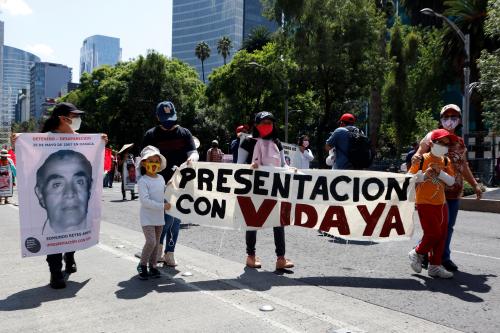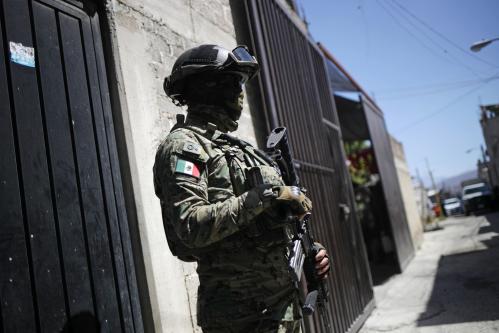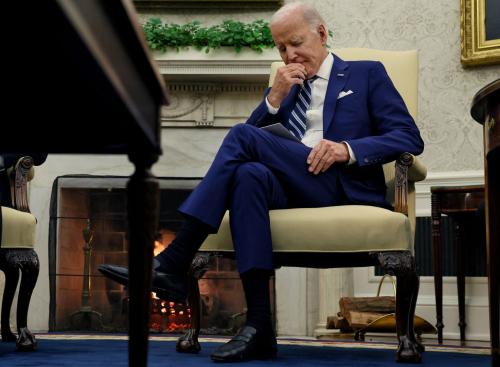While a serious, well-designed anti-crime strategy in Mexico is badly needed and overdue, any application of a “hotspot strategy” will not be without its challenges, as the successes of such strategies have often occurred in settings of a far smaller scale than Mexico, explains Vanda Felbab-Brown. This piece was originally published by Mexico Today.
In July, Mexican government officials started floating the possibility of adopting an anti-crime strategy focused on the country’s 50 most violent municipalities, though they haven’t yet revealed any details of such a strategy. At long last, the official statements indicated at least some recognition on the part of the Andrés Manuel López Obrador administration that the Mexican government could no longer just ignore the devastating criminal violence while hoping that some day abrazos, no balazos (the government’s assorted socio-economic programs focused on Mexico’s youth) would dry up violent crime. A serious well-designed anti-crime strategy is badly needed and overdue, and a hotspot strategy is well-tested and widely-embraced. But its successes have often occurred in settings of a far smaller scale than Mexico. Mexico has had its own recent version of the most-violent hotspots strategy – the polígonos approach of the Enrique Peña Nieto administration – and the López Obrador team would do well to study its struggles.
Criminal violence in Mexico remains devastatingly high. The government’s much touted datapoint — that between January and June 2021, homicides in Mexico declined by 3.5 percent in comparison with that same period in 2020, the second most violent year after 2019 — is just rhetoric. These changes are almost entirely driven by the ebb and flow of turf wars between criminal groups; they are a manifestation of the natural fluctuation in operational tempo of violent criminal markets or warzones. The 3.5 percent decline has hardly anything to do with law enforcement or anti-crime socio-economic policies. Moreover, almost 17,000 homicides in the first six months of 2021 should be unacceptable in any year.
A hotspot strategy is based on the premise that rather than dispersing scant and valuable law enforcement assets across an area uniformly, the government or local police department concentrates them in the area of afflicted by violence, and this will achieve robust incapacitation effects there and deterrence effects beyond the “treated” area.
But prior versions of a hotspot approach in Mexico suffered from several sets of problems:
- The incapacitation often did not work particularly well;
- The declines in violence often reflected principally temporary balances of power among criminal groups rather than being driven by policies;
- Violence-reduction dynamics – local instances of narcopeace – were left to the mercy of criminal groups and vagaries of criminal markets, and were not sustained by the federal or local government, and were unsustainable;
- Deterrence effects within the treated area, let alone beyond it, didn’t materialize;
- The pockets of stability and violence reduction were never expanded; and
- Thus, they eventually withered from both within and the outside, as violent criminality leaked into them from surrounding areas.
Viz., Peña Nieto’s polígonos. Seeking to differentiate its security strategy from the militarized anti-crime approach of the Felipe Calderón administration, the Peña Nieto government at first also strongly embraced socio-economic and cultural policies to combat and prevent crime. Funded at MXN $2.5 billion (approximately US $190 million) in 2013 on top of the line ministry funding the crime prevention program—the National Program for Social Prevention of Violence and Delinquency (Programa Nacional para la Prevención Social de la Violencia y el Delito, PRONAPRED)—it was to be implemented in 57 specially selected zones called polígonos (polygons).
However, just as with other components of Peña Nieto’s security strategy, the socio-economic crime prevention approaches left much to be desired in their operationalization and implementation. Putting aside the fact that the Calderón administration, with U.S. prodding, ultimately also embraced such socio-economic approaches and crime prevention (namely, in the Todos Somos Juárez program), and that Mexican states and cities were adopting such policies before Peña Nieto was elected (such as in Monterrey’s Colonía Independencia), the theory, implementation, and monitoring parameters of the national crime prevention strategy were not adequately worked out.
At first, the focus was almost exclusively on the cultural aspects of the programs, such as its music, extracurricular activities, and the psychological problems of Mexico’s youth (e.g., attention-deficit disorder). But the approach left unaddressed how these youth programs and cultural efforts were to interact with local and national policing.
Later on, numerous socio-economic initiatives were included—from distributing glasses to school children to various vocational programs. However, the Peña Nieto administration never effectively determined precisely which socio-economic programs with public benefits would qualify to be included, nor what their expected specific anti-crime impact would be. Also unspecified were the questions of when and how these wide-ranging elements were supposed to reduce violent crime. Policies that kept kids off streets and prevented gang recruitment seemed effective, but even they were highly contingent on security and the presence of DTOs in a particular area.
Legal job creation, was consistently the most elusive goal, and very few sustained jobs were actually created. In fact, the programming under polígonos, like similar programs around the world, was often quick vocational training –to become a seamstress, a hairdresser, a plumber, or an electrician – but not the actual jobs. Some beneficiaries were able to translate the training into sustainable jobs, others gave it go, but couldn’t make it in local constrained markets, others did not even try to parlay the training. Providing training (the go-to default of such efforts around the world) doesn’t equal actual jobs.
Indeed, creating legal jobs is the dominant challenge for most anti-crime, anti-violence, peace-building, disarmament, demobilization, and reintegration efforts from Colombia to Somalia to Nigeria to Brazil to Central America to Nepal. It’s frequently a struggle, because even if the programming goes beyond training into actual job creation or links up with firms that are interested in hiring the beneficiaries, the number of jobs generated – at best hundreds – is often an order of magnitude lower than the number of existing criminals or militants in such settings, and often fails to such an extent that it unravels the rest of the effort.
Nor were the socio-economic dimensions of the polígonos approach in any way merged with policing efforts. In lucky circumstances, policing efforts were concentrated in the same street or block (and yes, sometimes the scale within a polygon were as small as that!) where the socio-economic programs operated; but even then, there were few if any articulated or implemented lines of logic or points of contact between them. At other times, the policing efforts were going on in a different area than the socio-economic programs, the two happily ignoring each other. Law enforcement forces rarely wanted to have anything to do with the civilian administrators – a position especially of Mexico’s land military forces, SEDENA.
With López Obrador inappropriately giving SEDENA all kinds of civilian tasks — from building an airport, luxury apartments and new railways to being in charge of customs — could the defense forces develop appetite for doing the civilian part of “building” in anti-crime efforts, instead of just refusing to liaise and coordinate with the civilians?
And, will there be any logic of connection between the 50 selected most violent municipalities to receive anti-crime efforts and the location of the National Guard cuarteles (bases) being built in Mexico? And will the Guarda units get out of their new garrisons or be ineffectually stuck in them?
In the past, the lack of integration with law enforcement efforts also meant that the polygons were not insulated from leakages of violent turf wars from the outside. For example, turf fighting elsewhere in Chihuahua over illegal logging and drug trafficking also reverberated in Cuidad Juárez and amplified the re-escalating violence dynamics in the city resulting from the collapse of the narcopeace brought about by Sinaloa Cartel’s victory in the city in 2013. (After the extradition of the notorious boss of the Sinaloa Cartel, Joaquín “El Chapo” Guzmán’s extradition to the United States in 2017 and the rise of its Cartel Jalisco Nueva Generación rival, intense violence flared up and persists in the city as the Sinaloa Cartel has not been able to maintain and project its local power to deter internal alliance fragmentation and external aggression.)
Indeed, there was never any strategy to connect the polígonos with each other, nor was it ever attempted.
Overall, driven by political pressures to give most voters a little bit, even if it cannot achieve transformative effects, instead of concentrating resources, the money and efforts were dispersed over too many spaces. And by 2016, the funding ran out. Many programs and even physical structures built with the polígonos money literally crumbled. The islands of hope became islands abandoned by federal policy and not robustly picked up by state and local governments.
What then are some of key policy implications for the new approach contemplated in Mexico?
- To start with, the Mexican government should commission Mexican researchers to conduct detailed ground-based studies of each of the 57 polígonos to learn what worked at least temporarily, and to see if anything was preserved and why.
- Policing must be a robust component of the strategy. Relying on long-term socio-economic programs to suppress crime is not enough.
- The design of law enforcement efforts in the selected municipalities will need to be operationalized in great detail, with an eye toward sustainability and the creation of deterrence effects.
- Integrating smart local policing efforts with whatever actual socio-economic programming is contemplated will be essential – in detail, and from the beginning.
- A municipality is still a large area. It will be necessary to decide where within the municipality to concentrate and how to expand the effort. Otherwise, the resources deployed will be spread too thin.
- Taking on 50 municipalities at once is probably too ambitious. Such numbers are often driving by the logic of elections, instead of the logic of policy. Such a large number is too easily a prescription for temporarily putting out the most intense flames, only to have them intensify again as law enforcement shifts elsewhere, instead of achieving transformative effects. Instead, the rollout should be gradual across those most violent municipalities and concentrate on those close enough to each other so that concentric and expanding circles of security and stability can be built up. Otherwise, criminals will simply move out from the treated area temporarily, augment violence elsewhere, and eventually return with violence. This troubled dispersion and return was a key problem for the Pacification UPP program in Brazil.
- The socio-economic anti-crime components need to be buttressed by a concrete articulated theory of change, informed by evidence, instead of merely a collection of random or augmented preexisting programs. Keeping kids of the street to prevent recruitment is a good anti-crime tactic. Improving a water system is good for public health and human rights reasons; but does it actually have any meaningful impact on local crime dynamics?
- Finally, legal job programs need to go far beyond just training and actually focus on job generation. And the training delivered and jobs created have to be diversified – not everyone trained as a plumber or seamstress – needs-based, and appropriate for local market conditions.







Commentary
Op-edA hotspot anti-crime strategy in Mexico?
August 27, 2021